Only 12% of consumers are indifferent to whether a company responds to reviews.
The rest watch you like hawks – and fly off to competitors if your responses don’t pass the vibe check.
Responding to positive reviews is intuitive and a lovely experience for all parties. 🌈
But when you see a negative review for your business, your gut reaction might be to ignore it or to clap back. Both options are mistakes.
So, what is the ideal approach to negative feedback for businesses?
We’ll show you how to embrace critique as an opportunity to showcase your business with these productive negative review response examples.
//[inject:ad-reviews]
Why should you respond to negative reviews?
Responding to bad reviews promptly and helpfully is a sign of responsibility to consumers.
Responding to these negative online reviews shows that your company cares about its customers’ trust and experience, even when things aren’t all sunshine and roses.
Customers are paying attention. As a business owner, you must learn to turn negative reviews into positive reviews to maintain customer loyalty and positive feedback.
An independent international survey revealed that for 57% of consumers, product research and buying happens online – and out of those who shop in stores, 28% still research online first.
That’s 85% of shoppers scanning your site before they buy.
And what are they looking for in their research?
Positive and negative reviews. But when reading those reviews, 97% of customers also seek company responses to form an opinion about your brand.
So, it’s not just about the affected customer and their isolated incident.
Your online reviews and responses (positive and negative) shape your brand image and affect how each future visitor perceives you.
The difference is that unanswered negative reviews raise the alarm to the audience.
Impact of negative reviews on your eCommerce reputation
Increasingly, customers trust online reviews and care about transparency. They don’t blindly trust stores – before committing, they need to see social proof.
Positive reviews aren’t enough.
We’re all on the lookout for fake online reviews in 2023, and one of the biggest red flags is a perfect five-star score without a trace of criticism in sight.
People want to see the good and the bad.
If anything, they care more about the bad reviews in their search for a balanced and truthful perspective.
How you respond to negative reviews matters because people are reading them.
They’re not just looking for dirt, either: 9 out of 10 customers are more likely to overlook a bad review if you react to them adequately.
After all, if they’re considering making a purchase, customers want to know what kind of treatment they can expect from you, especially if they run into problems.
The main thing to remember is that consumers trust and relate to what other consumers think about your business because they might end up in the same situation.
They’re thinking: I’m one purchase away from being this reviewer.
Responding to negative reviews can sway their buying confidence, so it’s worth thinking carefully about your own responses.
The lack of a negative review response already says something: You don’t care, so potential customers, beware!
Since that’s not the case, you better reassure the audience fast.
How quickly should you respond to a negative review?
Over half of consumers expect a review response within a week. Some believe it should be even faster.
But let’s address the elephant in the room…
Why shouldn't I delete negative reviews?
Nobody likes criticism. But online criticism on review sites that are easily accessible to search engines? It’s the last thing you’d like your loyal customers to read.
We’re not judging if you’d rather sweep it under a digital carpet and pretend nothing happened.
But resist the urge.
Deleting negative reviews can seem like you have something to hide.
Of course, this doesn’t include fake reviews – you can and should filter out blatant trolling and slander that could otherwise harm your business or customers.
But genuine negative reviews? Embrace them.
Understanding why people expect and want to read negative online reviews in the first place can help you deal with them.
They’re not sitting there thinking, “This company pretends it’s perfect, but I bet I can find some dirt on it!”
When responding to negative reviews, consider that customers are focusing on their doubts:
- Can I trust this company?
- Am I in danger of getting ripped off?
- How were other customers treated, and what were some issues that they experienced?
They study negative and positive reviews and responses to gauge how big of a gamble they’re making if they engage with you.
You can use these opportunities to ease your customers’ worries and prove that you aren’t merely trying to empty their pockets.
Below are eight strategic negative review response examples that show you how to bounce back from criticism. 👇
8 best responses examples for negative reviews
So now that you aren’t deleting negative reviews, it’s time for battle – assemble the troops and get ready!
Just kidding.
It is essential to learn how to respond to negative reviews because it shows your brand's integrity, whether you’re a small local business or a corporation.
Don’t be dismissive or defensive, launch a personal attack, or add insult to injury, even if the negative customer feedback you received seems a bit exaggerated.
Canned responses are also not ideal. Case in point:
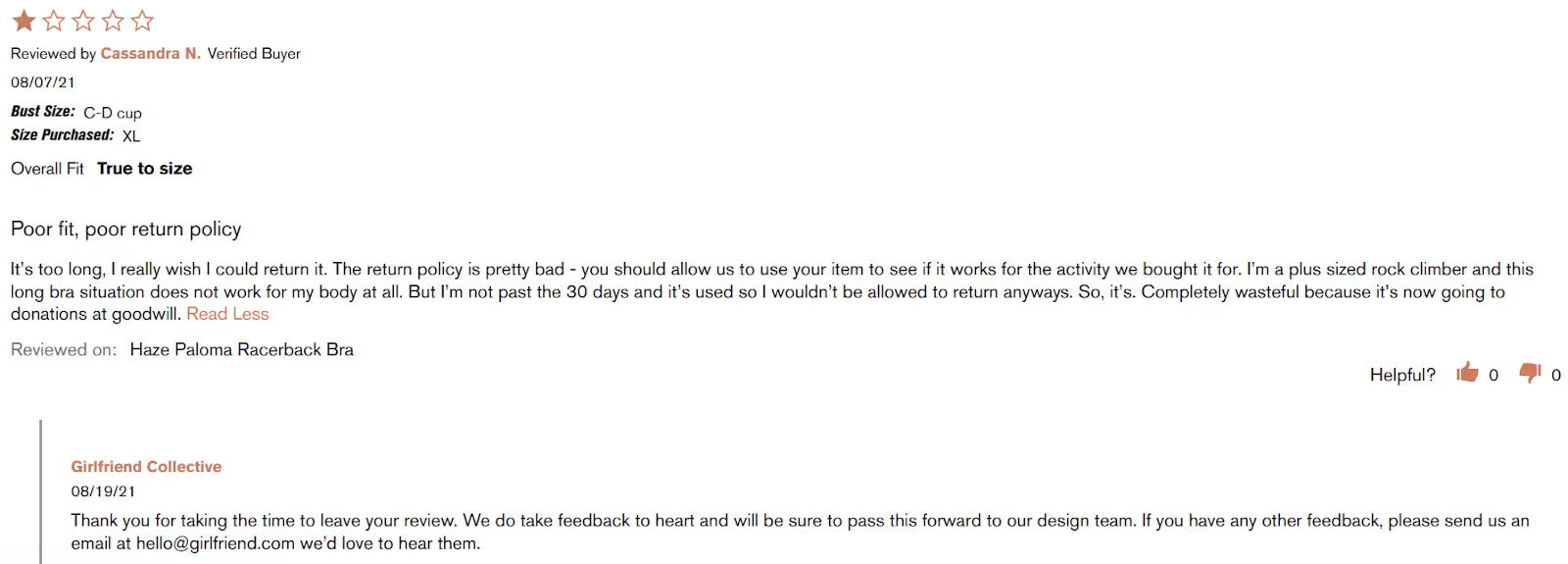
Remember that your responses to negative online reviews reflect your company’s values. One thing you shouldn’t do when responding to negative reviews is to prove you don’t care about your customers, as any sort of canned response effectively does.
What could they have done better? If we had to guess:
- Acknowledge the specific concerns mentioned in each negative review
- Address the reviewer by name
- Suggest an alternative that could better suit the reviewer
- Consider offering a replacement or refund
- Not slap the same generic response on other negative reviews
“Sorry” only goes so far, especially when you only respond to a handful of negative reviews using the same apology.
Now, let’s look at the bad review response examples from eCommerce companies that did it right.
1. Defective, broken, or used product
The product is defective, used, or damaged during shipping due to poor packaging.
On the review site, you might read something like this:

Now let’s study this first-class response from Harts of Stur:
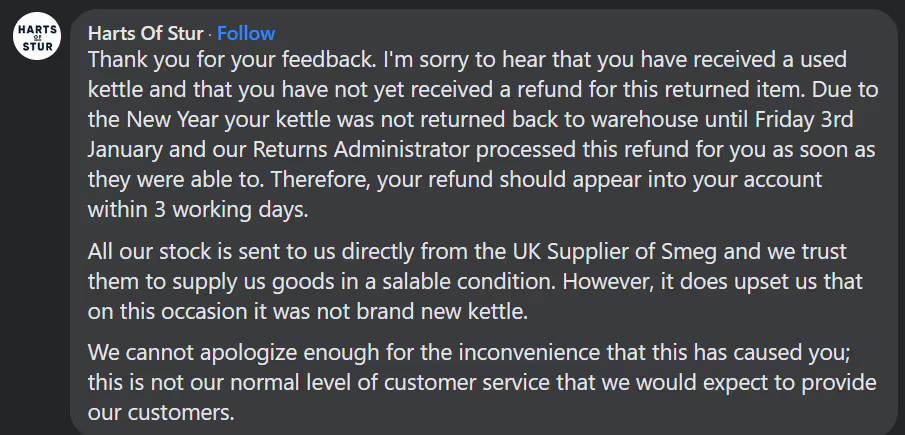
What we love about this:
- It’s not a stock response – the company read and addressed the points from this specific review
- It was accountable – it explained this was an exception to its usual high-quality standard, but without diminishing the complaint or deflecting blame
- It fixed the problem – it issued the refund and explained the procedure to clarify when it will arrive
A big round of applause for Harts of Stur for how they respond publicly to almost every negative review.👏
2. Slow or unhelpful service
Poor customer service is one of the most common complaints from shoppers.
.avif)
It usually happens in tandem with an initial problem that the unhappy customer reported to the brand, only to be further agitated by the lack of customer support.
Sometimes that’s not anyone’s fault. Maybe the email didn’t land in your inbox, so it went under the radar.
Whatever happened, words can’t compensate for poor service. But you know what can? Adequate support!
Go the extra mile to help in any way you can and address the customer’s concerns.
But what if their concerns are vague? Here’s a great response example when the reviewer yells unconstructive criticism at you in all-caps:

This response from Bo + Tee does everything right:
- Addresses the reviewer by name
- Accepts the negative review and apologizes
- Asks for clarification in a direct message
- Offers to fix the problem
No arguing and no impersonal “we value our customers” statement while doing nothing to prove it.
That’s how you get happy customers.
3. Shipping issues
Shipping is one of those issues that aren’t always under your control, yet you’re the one getting the heat.
But remember, that’s not the point. The point is the customer’s negative experience.
They didn’t receive their order in time, or at all.
Maybe it was intended as a special occasion gift, but it’s already past the date, or they had to pay unexpected extra fees and, understandably, they’re angry.
Here’s an example of a tactful response that centers around the reviewer:
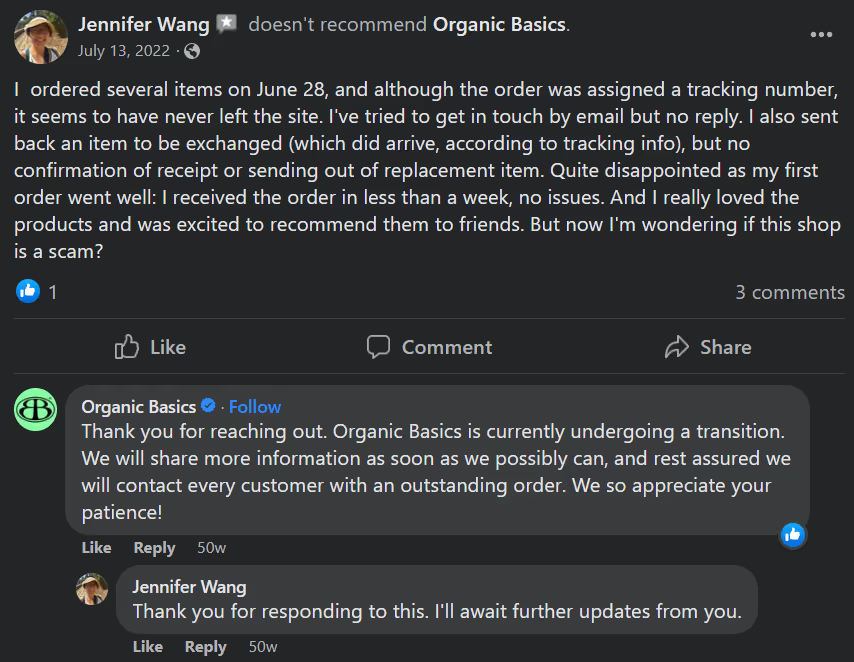
Ideally, the company would be able to immediately fix the problem.
However, if there’s a technical issue preventing that, getting back to the reviewer is all the more urgent.
Based on their comment, you can tell the reviewer appreciates the response, too. Perhaps Organic Basics even managed to retain them despite their initial negative review.
4. Receiving the wrong product
Double-trouble:
- The customer didn’t receive the product they wanted
- They did receive something they didn’t order, and now it’s a hassle to deal with
Here’s how a frustrated customer felt about this situation:
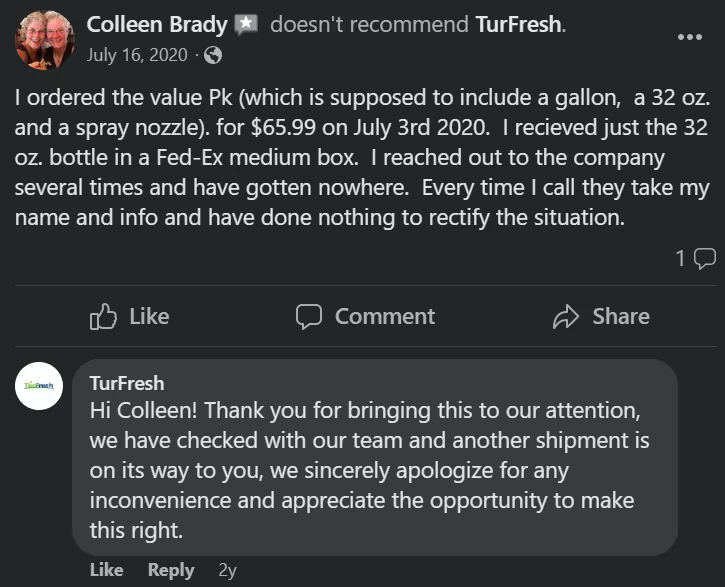
This response from TurFresh feels genuine and shows the company rectifies their mistakes.
Now, the reviewer gets a positive resolution, feels better about your business, and maybe even reconsiders their rating.
We’ll get the champagne! 🍾
5. No returns or refunds
Presenting: one of your potential customers’ biggest fears and a common source of negative feedback.
One-star reviews about refunds are particularly important to address now, during a recession, or they could scare potential customers away.
Here’s an example. The reviewer criticizes the requirement to print their own label when a printer is hardly accessible in the middle of lockdown:
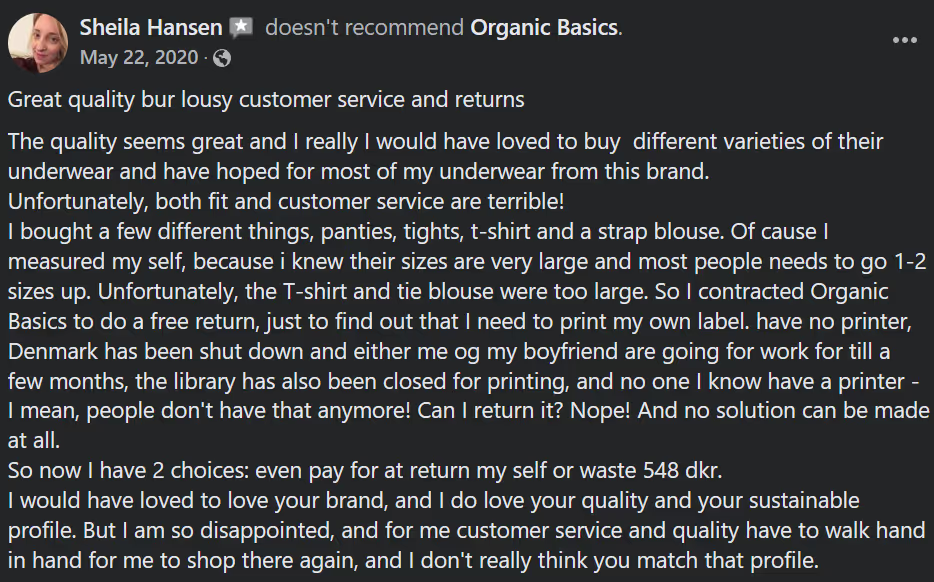
This response is as good as it gets in the given situation:
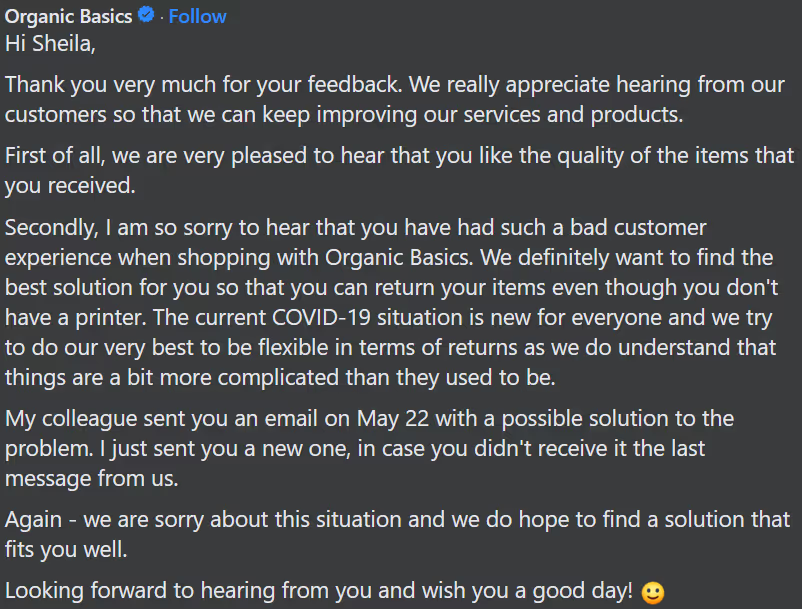
The company gracefully addresses each point in the review so the problem is fully resolved, and the customer feels heard.
Other things you can do when responding to negative reviews, depending on the situation:
- Summarize your refund or return policy
- Let the client keep an item they refunded to make up for the trouble
- Send them a voucher to show goodwill
- Offer a real money-back option, not just store credit
6. Issues with the website
Imagine this: A customer is ready to buy your product, but something goes wrong with your website.
Perhaps the product shows up as “unavailable,” or their payment isn’t being processed.
After much unnecessary hassle, they give up.
It’s a shame. But, if you react quickly enough and solve the problem, you might still win the customer over and improve your rating.
Here’s an example:

The good thing about this response is that the company is addressing all of the issues the reviewer had. It’s not just an “Oh no! Anyway…” type answer.
They:
- Explain why they can’t guarantee the utility is processed quickly
- Mention a potential solution to make it quicker
- Offer to discuss the payment problems further
And it’s fine to move the discussion to direct messages or email. We don’t need to see exactly how they resolve everything, just that they respond promptly and helpfully.
7. Not the right match
Sometimes, everything goes according to plan, but the fit is wrong for the customer.
Or, in this case, the shade isn’t right:
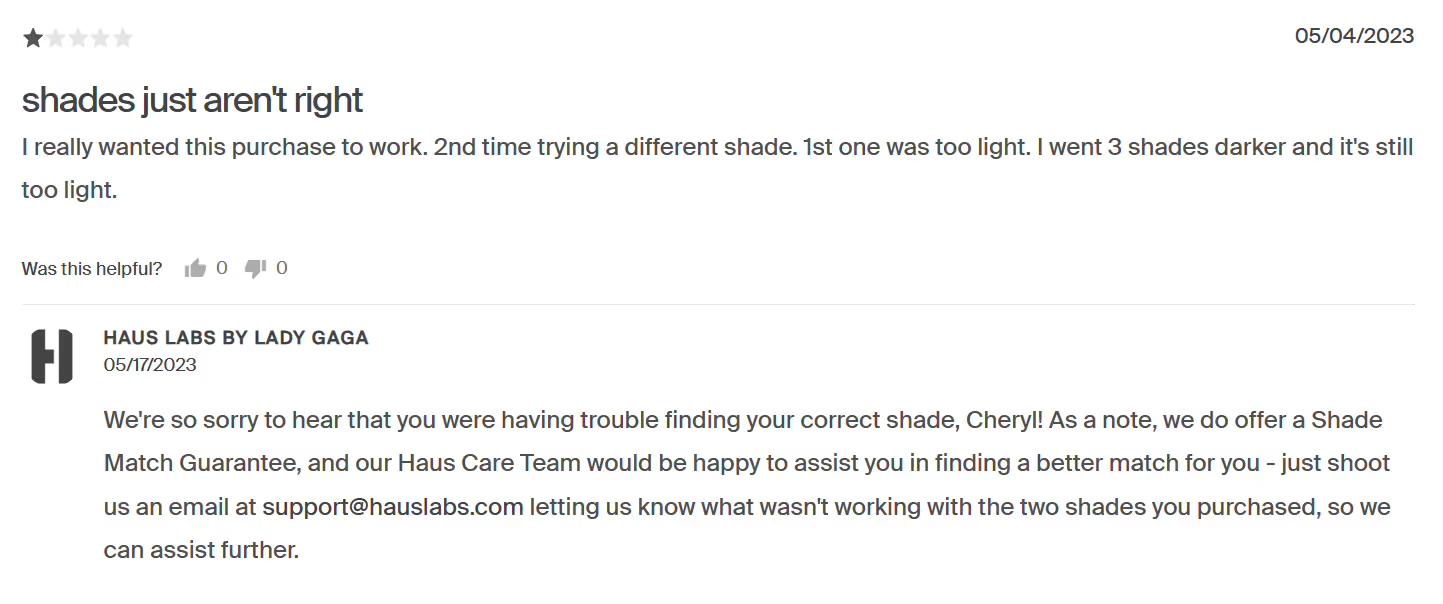
There’s still some wiggle room here, as Haus Labs pointed out. Instead of losing the customer, they try to assist with finding the right match:
- Mention relevant policies like their guarantee that ensures potential customers don’t lose money for each shade they try, which is a brilliant idea on its own
- Offer support service, which, again, makes sense for things that need to be an ideal match, like makeup or bras
- Ask for more details
Maybe the reviewer didn’t even know they were eligible for a refund, so this negative review response has to delight them and potentially restore some confidence in the brand.
8. Inconsistent product quality
Nothing’s worse than finding the perfect appliance with all the right features and thinking, finally, something you can rely on – only to have a completely different customer experience with the next purchase.
If this complaint repeats a couple of times, it’s probably a manufacturing issue you should look into.
In the meantime, here’s how to respond:
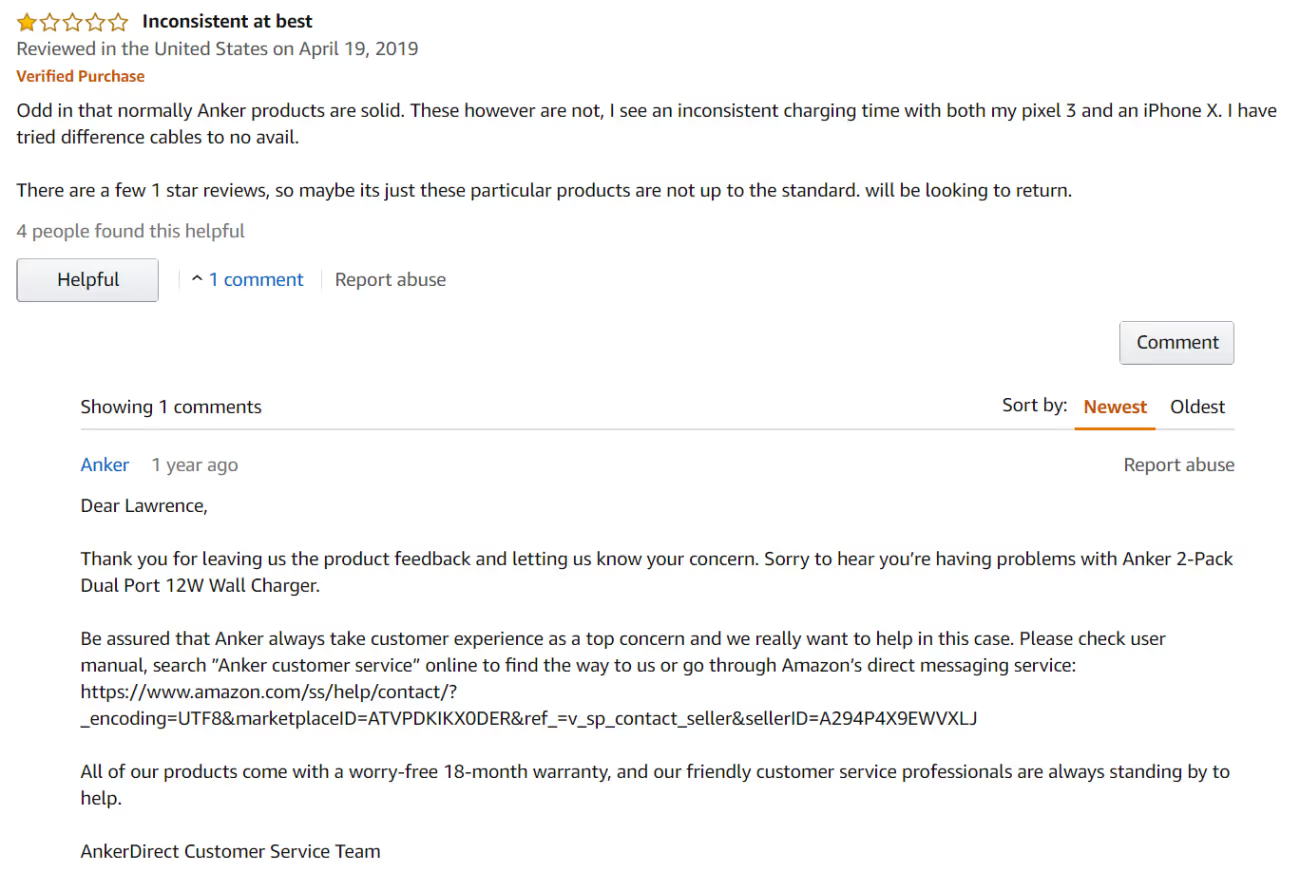
5 best practices for writing negative review responses
Okay, time to whip out your thinking hat and plan your negative review responses.
Objective #1? When responding to negative feedback, don’t make the situation any worse than it already is. That will only result in another bad review from the (now) angry customer.
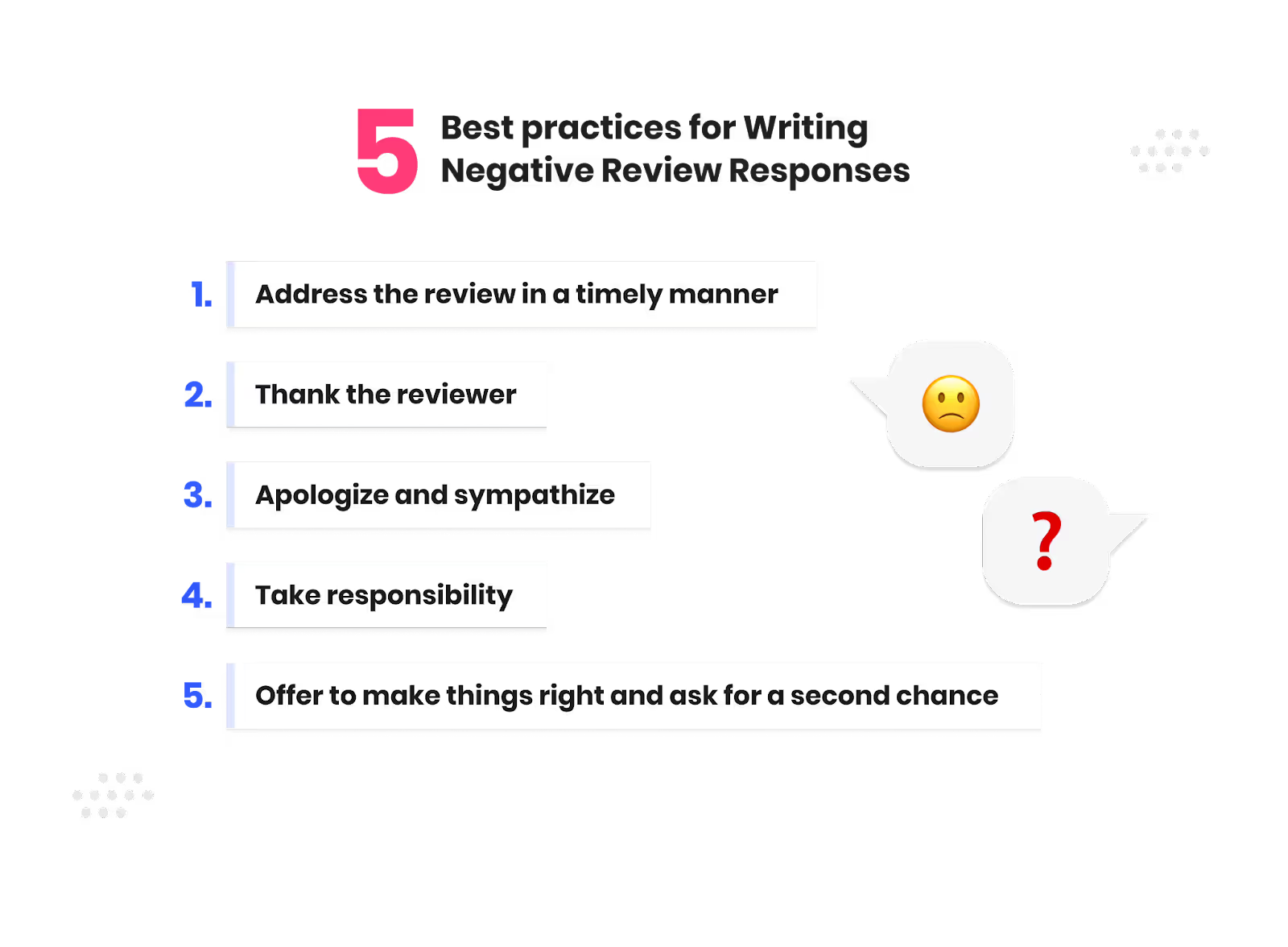
1. Address the review in a timely manner
Be swift to show your customers are your priority.
Research shows that only a third of customers believe that retailers review their feedback, while 16% think companies don’t use customer feedback to change anything.
So, the first thing you can do is buck that trend. Address all your negative customer feedback immediately and watch your company name become a household name as a caring company.
It’s not just a sweet gesture. The issue has a high probability of being time-sensitive due to:
- Your refund and return window
- The warranty period
- External factors like upcoming holidays or customers’ plans
If the dissatisfied customer purchased your product as a birthday gift and the birthday is long past by the time you’ve addressed their negative review, your apology might be too little too late.
Still better than nothing! But try not to let it get to that point.
2. Thank the reviewer
When you read a negative review, it may feel like a punch in the gut because the truth isn’t always easy to hear.
A negative review is still valuable feedback.
The whole point of customer feedback, especially negative feedback, is to tell you how well you’re serving your customers. Don’t let your ego get in the way – if you’re falling short, you need to know so you can do better.
The customer is doing you a favor by letting you know. So thank them!
3. Apologize and sympathize
After your initial line thanking the customer for their feedback, apologize for the inconvenience.
Their negative review might be emotionally charged.
Remain calm. Look past the customer’s tone and think about where they’re coming from. They trusted you and got burned for it, so, of course, they’re upset.
For the love of all that is pure, don’t be sarcastic, downplay the complaint, or say, “You’re overreacting.” That’s only going to make things worse.
Express your sympathy and focus on what’s under your control.
4. Take responsibility
When you address negative feedback, justifications can water down the apology.
You must take a moment to acknowledge you wronged the customer and take full ownership of it.
Accountability is the first step to making amends. But, more importantly, follow it up with a solution.
5. Offer to make things right and ask for a second chance
Words only go so far, so don’t end it with “sorry to hear that.”
If you don’t take action to make things right, consumers are inclined to think you don’t mean it – you’re just doing damage control and trying to maintain your reputation.
You need to make it about the customer. Go out of your way to solve the problem, and let that speak for your intentions.
For example:
Problem
Solution
The dress was in the wrong color?
Send a free replacement and a coupon.
They felt that your marketing was misleading about a feature?
Clarify your copy to better reflect reality.
The package arrived too late, and your policy doesn’t allow returns?
Make an exception, take the conversation offline, send a small gift, or pay back their money.
These actions show you take your customers and their feedback seriously. If something goes wrong, you’ll fix it, so they have no reason not to trust you.
But above all, always keep your promises!
Saying you’ll make it right and not following up is a recipe for disaster. All you’ll get is further negative reviews.
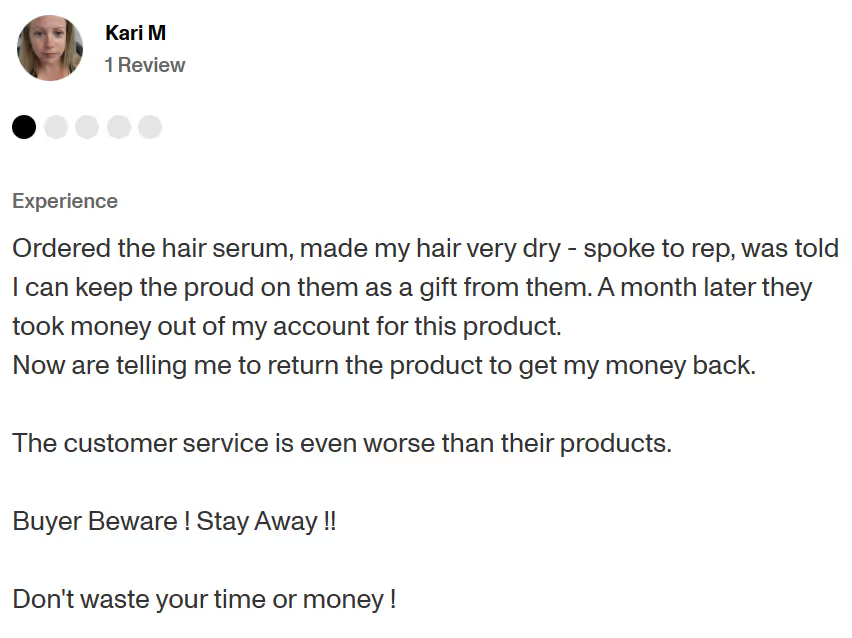
How to manage your eCommerce reputation strategically
Now, you can put out fires as they come along.
But let’s go beyond already published negative customer reviews and talk about a proactive reputation management strategy.
Review moderation with Sendlane
Deleting published negative reviews on any platform, including Google reviews, is not good unless they’re obviously malicious or fake.
But there is a step before publishing: review moderation.
Your Sendlane dashboard is a hub where you collect and manage all your reviews.
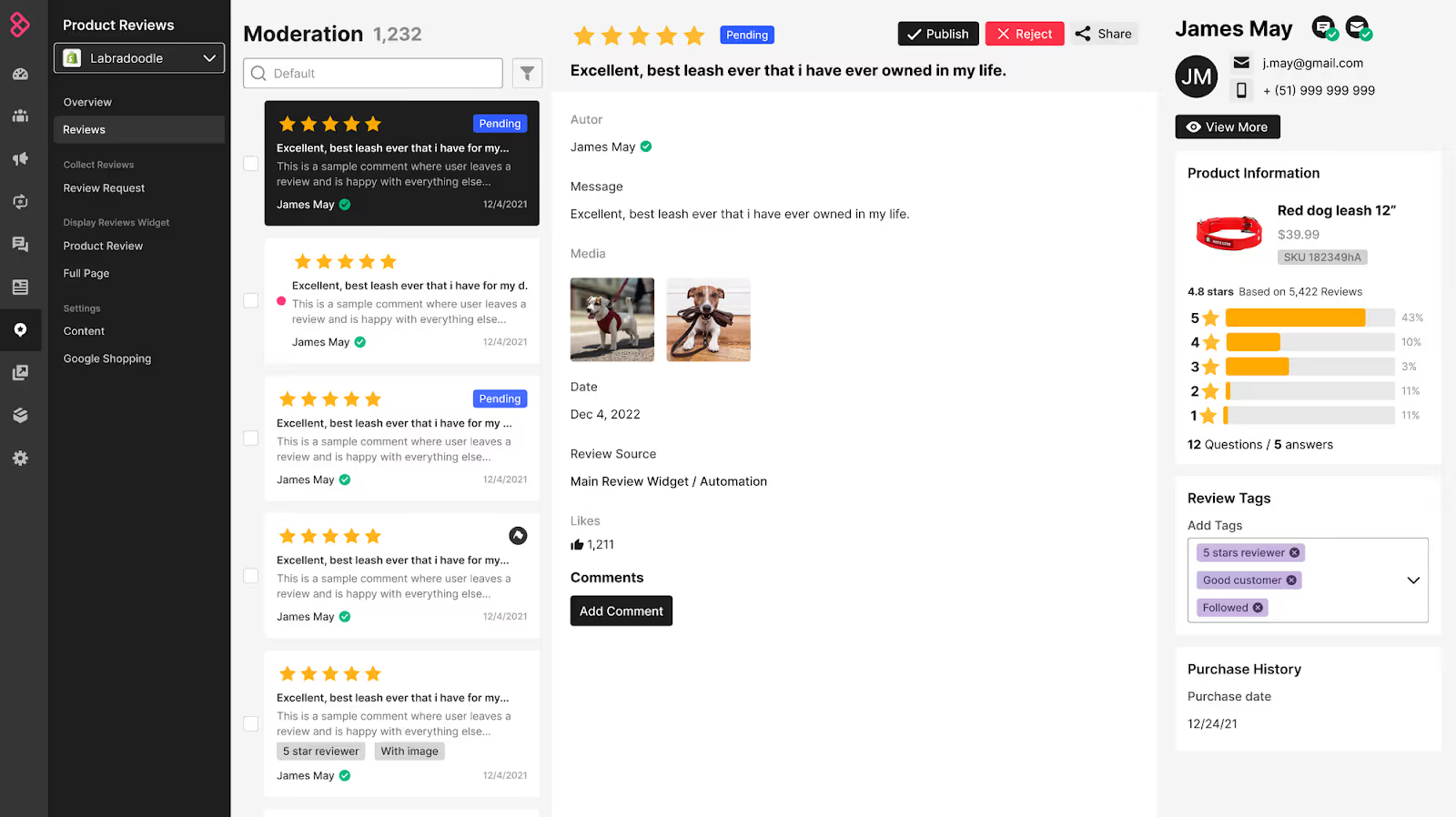
Anything anyone writes about your products goes to this waiting room in a dedicated “Product Reviews” interface, where you decide what makes it to your product reviews on Shopify or BigCommerce and what goes in the bin.
As a business owner, you control the process, so reputation management becomes easy.
Instead of constantly playing catch-up and publicly dealing with every random thought people have about your brand, utilize review moderation in Sendlane to:
- Get an overview of all feedback in one place
- Decide what gets published and what does not at your own pace
- Kill fake and damaging reviews at the root
- Never miss a review or forget to respond
Manage unhappy customers using Sendlane
If we’ve hammered one point in by now, it’s that you can’t leave unhappy customer reviews unanswered.
But this doesn’t just go for reviews.
Have you noticed a pattern among customer complaints? Re-reading our examples above, you can see that most reviewers specifically say they’ve tried to resolve the issue with the company first, to no avail.
They resort to poor ratings once they’ve already given up.
With Sendlane, you can keep all your communication at your fingertips and get through to customers in a timely manner, preventing many of those unwanted reviews from happening in the first place.
It lets you stay on top of all customer messages, follow up on time, and ensure customer satisfaction. You can request a demo to learn more about it.
Integrate reviews in emails campaigns and automations
Quick question: When you buy a product online, do you tend to return to the website to find the right page and leave a review?
Most of the time, probably not. Your customers don’t, either. But luckily, you can put the ball back in their court via email.
Most online stores have a post-purchase funnel. It looks something like this:

In Sendlane, you can automate this process so customers can send you a review once they confirm delivery without requiring you to move a finger.
Here’s an example of a feedback email automated workflow:
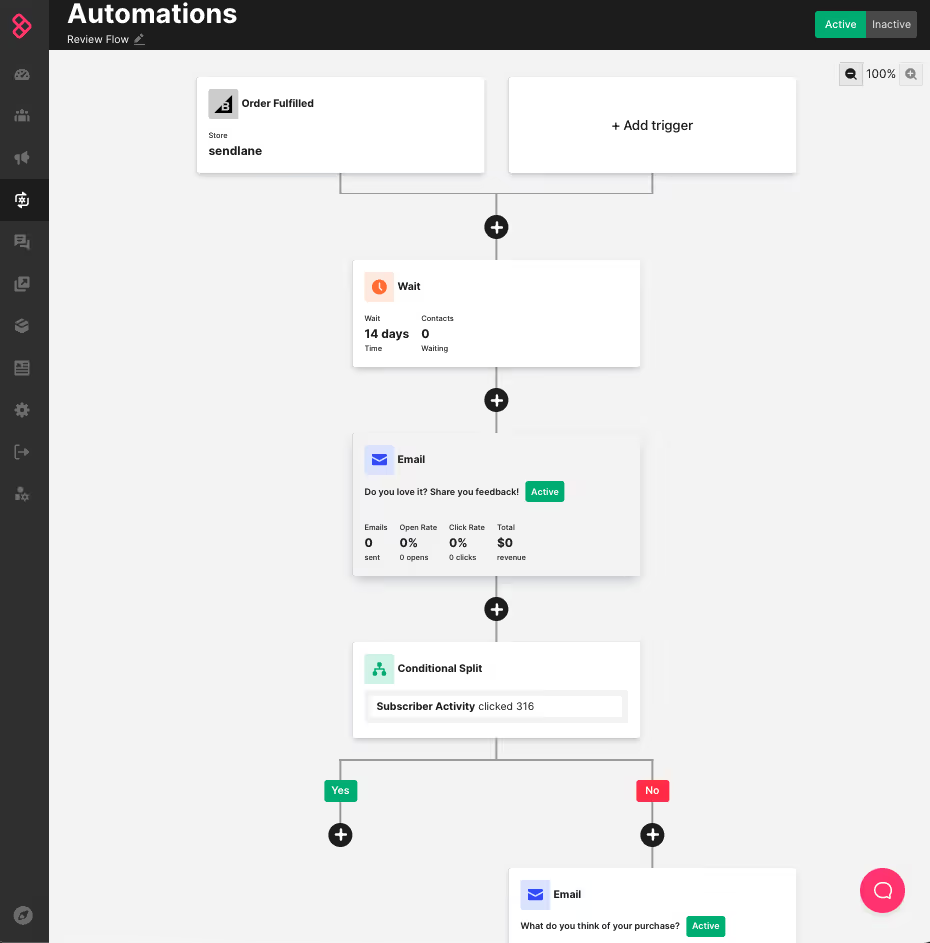
Bonus points if the business owner explains to customers why the feedback matters to incentivize an honest and specific response instead of a one-word answer.
If you want to integrate reviews in campaigns to aid with reputation management, here are more review request email examples.
Utilize all the data points to better segment your targeted audience
Ultimately, it’s all about knowing what your customers need so you can cater to them. Your brand reputation revolves around how well you can do that.
You need to be an active listener, using customer data from multiple platforms to improve your segmentation and understand your audience better.
So how do you do that? In Sendlane, you can:
1. Track deep data through its integration with Shopify and WooCommerce

2. Create lists, tags, and segments to keep a hyper-specific log of each customer
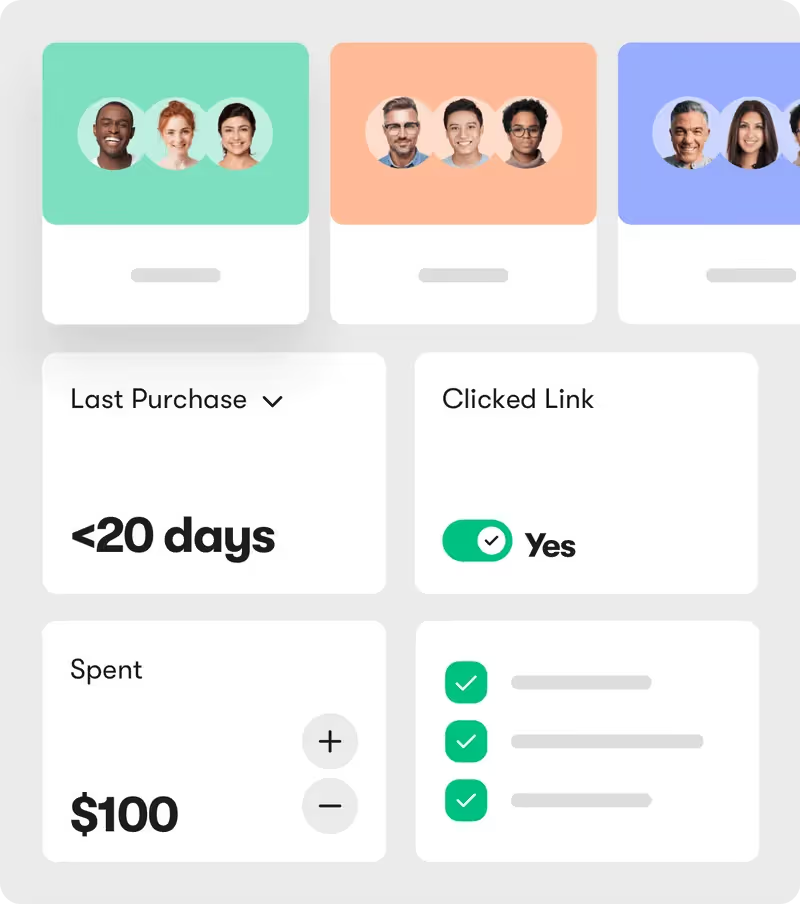
3. Use real-time analytics to get accurate data synchronization across multiple channels to know what your audience thinks about your current marketing efforts

This is how you stay one step ahead and nurture a loyal customer base.
You learn from their brand interactions and make increasingly accurate predictions of what they might like or need next.
Customers feel taken care of, which elevates your business name.
//[inject:ad-demo]
4 ways to rebuild your reputation after negative reviews
So, you’ve answered your bad reviews and done your best to make things right.
Let’s talk about four more steps you can take to rebuild and maintain your reputation.
1. Identify trends in your negative feedback
Similar complaints can highlight issues with your product or processes and help you in the long run.
For example:
Feedback
Underlying problem
Everyone complains about the same feature or the lack of a feature
Your new epilator doesn’t have a built-in light, so people can’t see what they’re doing
The product is fine, but a particular audience segment doesn’t mesh well with it
People with oily skin specifically report issues with your sunscreen formula
People feel blindsided by policies they weren’t aware of before purchasing
Some key shipping or refund information isn’t in the right place on your website, so nobody reads it
If it keeps happening, it’s not a coincidence.
Look for themes across all your eCommerce reviews platforms for an accurate overview.
2. Accept the feedback and use it to improve
Use the feedback to implement changes.
Making changes is where you show you mean it when you apologize for inconveniences and promise to do better.
It’s not just about making changes for the sake of it. They should respond to the specific demand you identified in your audience.
Whether it’s better service, a new product version, or an improved website user interface – if it was inconvenient enough that your customers complained about it, it’s worth fixing.
3. Publish positive content to show you’ve addressed the pain points
Let the world know you listen to your customers!
Own your reviews as part of your brand story. Be vocal about where you were falling short, what you’ve done about it, and how you’ve made progress.
People love a good character arc. Plus, the next time you say, “We care about our customer experience,” they will have a few reasons to believe you and not roll their eyes.
4. Turn past negative reviews into testimonials
Once you’ve done the work and made amends, return to your past negative reviewers and see if they changed their minds.
Take the conversation offline with a phone call, send them a gift, or add loyalty points to their account to incentivize customers to give you another chance.
Suggest they update the review to reflect the current reality with this fresh new customer experience in mind.
(Of course, never ask people to lie or tell them to leave a positive review.)
Ultimately, you want to turn those learning experiences into positive reviews that get new customers in the door.
Use these negative review response examples to turn criticism into redemption stories
Thanks to the internet, what used to be just a passing thought or comment between friends can easily be immortalized online and seen by millions.
Everything is public, including:
- Comments about your company (legitimate or not)
- Your responses and exchanges with customers
- Your business practices
These things shape your online reputation.
Since you can’t and shouldn’t stop them, you might as well take the wheel with a proper reputation management strategy that proactively writes your own story.
Sign up for a free trial with Sendlane if you need help executing that strategy at scale without breaking a sweat.
Not getting that much feedback in the first place? Get the ball rolling with these product review email templates.



%20(1).avif)




%20(1).avif)
%20(1).png)
.avif)


.avif)
.avif)


.avif)





.avif)



.avif)





.avif)


.avif)

.avif)
.avif)

.avif)
.avif)

.avif)

.avif)


.avif)
.avif)
%20(1).avif)
.avif)









.avif)











.avif)
.avif)

%20(1).avif)

%20(1).avif)



.avif)


























.avif)











































.avif)



.avif)




























.avif)



.avif)

.avif)

.avif)
.avif)


.avif)













.avif)

.avif)










.avif)












.avif)






































.avif)



.avif)

.avif)

.avif)
.avif)

.avif)
.avif)

.avif)

.avif)

.avif)

























